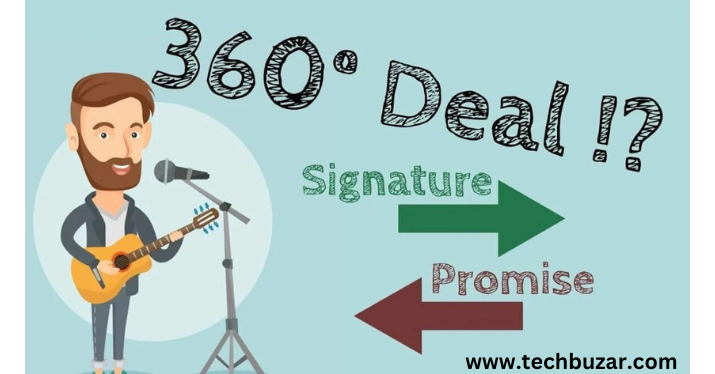
What is a 360 Deal: 100% Understanding the Comprehensive Contracts in the Music Industry
In the dynamic landscape of the music industry, artists often seek various avenues to secure their careers financially and artistically. One such avenue is a 360 deal, a comprehensive contract arrangement that has gained prominence in recent years. In this article, we delve into the intricacies of 360 deals, exploring their components, pros and cons, misconceptions, real-life examples, and their impact on artists.
Understanding the Components of a 360 Deal
Defining a 360 Deal
A 360 deal, also known as a multiple rights deal, is a contractual agreement between an artist and a music company or record label wherein the company receives a percentage of all aspects of the artist’s career, including but not limited to recording, touring, merchandise sales, endorsements, and publishing rights.
Key Players Involved
In a typical 360 deal, the key players involved include the artist, the record label or music company, managers, lawyers, and sometimes even agents. Each party plays a crucial role in negotiating and executing the terms of the agreement.
Scope of Control
One of the defining features of a 360 deal is the extensive control exerted by the record label or music company over various aspects of the artist’s career. This control extends beyond traditional recording contracts, encompassing revenue streams such as live performances, merchandise sales, and endorsements.

Pros and Cons of 360 Deals
Advantages
- Financial Support: 360 deals often provide artists with upfront advances and financial support for their projects, helping them fund recordings, tours, and promotional activities.
- Comprehensive Support: With a record label’s involvement in multiple aspects of their career, artists may benefit from extensive support in areas such as marketing, distribution, and brand management.
Disadvantages
- Loss of Control: Signing a 360 deal means relinquishing a significant degree of control over one’s career to the record label, which can lead to creative restrictions and limitations.
- Financial Obligations: Artists may find themselves indebted to the record label, as the company typically recoups its investment from the artist’s earnings across various revenue streams.
Common Misconceptions about 360 Deals
Despite their prevalence in the music industry, 360 deals are often misunderstood. One common misconception is that all 360 deals are exploitative and unfair to artists. While some agreements may indeed be disadvantageous, not all 360 deals are created equal, and careful negotiation can lead to mutually beneficial outcomes.
Real-Life Examples of 360 Deals
Several prominent artists have entered into 360 deals throughout their careers, with varying degrees of success. Examples include Madonna’s partnership with Live Nation, Jay-Z’s deal with Roc Nation, and Rihanna’s agreement with Roc Nation and Universal Music Group.
How to Navigate a 360 Deal Successfully
Negotiation Strategies
When entering into a 360 deal, artists should prioritize negotiating favorable terms that balance their artistic freedom with financial security. This may involve seeking legal counsel, conducting thorough research, and leveraging their bargaining power.
Legal Considerations
Given the complexity of 360 deals, it’s essential for artists to fully understand the terms and conditions outlined in the contract before signing. Consulting with experienced entertainment lawyers can help artists navigate the legal intricacies and protect their interests.
Impact of 360 Deals on Artists
360 deals have a significant impact on artists’ careers, shaping their creative output, financial stability, and long-term prospects in the industry. While some artists thrive under these arrangements, others may struggle to maintain autonomy and artistic integrity.
Alternatives to 360 Deals
As the music industry evolves, artists have increasingly explored alternative business models that offer more flexibility and control over their careers. These alternatives include independent distribution, crowdfunding, and licensing deals, among others.
The Future of 360 Deals in the Music Industry
While 360 deals remain prevalent in the music industry, their future is subject to ongoing debate and evolution. As artists continue to assert their independence and explore alternative revenue streams, record labels may need to adapt their approach to remain relevant in an ever-changing landscape.
Conclusion
In conclusion, 360 deals represent a complex yet integral aspect of the modern music industry, offering both opportunities and challenges for artists seeking to advance their careers. By understanding the components, pros and cons, and real-life examples of 360 deals, artists can make informed decisions and navigate these agreements successfully.
FAQs (Frequently Asked Questions)
- Are all 360 deals the same?
- No, 360 deals can vary significantly depending on the terms negotiated between the artist and the record label. It’s essential for artists to carefully review and negotiate the terms of the agreement to ensure they align with their goals and interests.
- Can artists maintain creative control in a 360 deal?
- While 360 deals often involve some degree of creative control by the record label, artists can negotiate provisions in the contract to protect their artistic integrity. Clear communication and collaboration with the label are key to maintaining creative autonomy.
- What are the alternatives to signing a 360 deal?
- Artists exploring alternatives to 360 deals can consider independent distribution, crowdfunding, licensing agreements, and self-releasing music through digital platforms. Each option offers varying levels of control and flexibility over the artist’s career.
- Do 360 deals benefit emerging artists?
- While 360 deals can provide financial support and resources for emerging artists, they also involve relinquishing a degree of control over their careers. Emerging artists should carefully weigh the pros and cons before entering into such agreements.
- How do 360 deals impact revenue distribution for artists?
- In a 360 deal, revenue generated from various sources, including recordings, tours, merchandise, and endorsements, is typically shared between the artist and the record label based on the terms of the contract. The specific revenue distribution varies depending on the negotiated terms.


